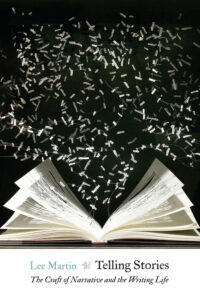Lee Martin's Blog
November 17, 2025
The Last Time I. . . .
 After my father was dead, and after my mother could no longer live independently, the task of dealing with their property fell to me, their only child. I remember, with an ache that never left me, the days I spent alone in their home, sorting through personal papers, deciding what to keep and what to send to the trash. I came upon old photographs, land deeds, bank statements, appliance manuals, grocery lists—everything that documented the lives they lived in what would soon be someone else’s house. I engaged an auctioneer, and by the end of the week, everything would be sold. Soon thereafter, I sold the house on contract and went back to my own life.
After my father was dead, and after my mother could no longer live independently, the task of dealing with their property fell to me, their only child. I remember, with an ache that never left me, the days I spent alone in their home, sorting through personal papers, deciding what to keep and what to send to the trash. I came upon old photographs, land deeds, bank statements, appliance manuals, grocery lists—everything that documented the lives they lived in what would soon be someone else’s house. I engaged an auctioneer, and by the end of the week, everything would be sold. Soon thereafter, I sold the house on contract and went back to my own life.
I never forgot, though, the days and nights my parents and I spent in that small frame house at 236 West Locust Street in Sumner, Illinois. In the autumn of the year, we picked up black walnuts that had fallen to the grass from the tree beside our garage. We raked our leaves onto a tarp and carried them to our garden where they would decompose and provide a natural fertilizer for next spring’s planting.
When the temperature dropped, my mother’s cooking fogged up the kitchen windows. I stood in the front room, watching for my father, eager to see him walking down the sidewalk, returning from time spent loafing uptown in Tubby’s Barber Shop, always carrying with him a new joke to tell. After supper, I carried the trash to our burn barrel along the garden’s edge and set it afire. I listened to the dogs barking from their pen behind the garage. I smelled the must of dead leaves, and if someone had burned some earlier, the scent would be in the air and wisps of smoke would rise from the drainage ditches that ran along the edge of the street.
On Friday nights, we listened to a high school basketball game on the radio. We sat around our kitchen table, and my mother popped corn and sliced apples and opened bottles of Pepsi-Cola. At ten o’clock, she turned on the television in our family room so she could watch the evening news. On exceptionally cold nights, I stood in front of our gas heating stove, letting it warm my back.
Then we all lay down to sleep. I woke at seven o’clock to the sound of a State Farm Insurance jingle on the radio. My mother was up, preparing breakfast, and soon she’d call to me to get out of bed. The day stretched out in front of us. That day and the one after it, and on and on, all of us blind to the fact that the time would come when there would be no more days in that house.
Which brings me to consider the last time we occupied a space that was important to us, and how that might provide a writing prompt, either in fiction, poetry, or creative nonfiction. Maybe, like me, you’ll recall a house where you once lived, or maybe you’ll remember a workspace, or a classroom, or a coffee shop. Any place that mattered to you once upon a time will do the trick. Write something—poetry or prose—that has to do with the last time you were there. Why was it hard to leave? Did the leaving involve also saying goodbye to someone? What didn’t you know when you finally left? What was waiting for you in the days and months and years beyond this last time? Let the writing take you wherever it wants to go. Maybe you’ll remember a love that has gradually ebbed. Maybe you’ll find yourself filled with resentment or rage. Maybe you’ll smile sweetly, thinking of all you left behind. Maybe you’ll forgive yourself or someone else. Maybe you’ll remember the life you had, and the people who shared it with you. Let the details do the work. Start a sentence with the words, “The last time I. . . .” See what looking back can tell you.
In many ways, though it’s been nearly forty years since my parents were alive, in my memory my mother is cooking supper in our kitchen, and I’m standing at the front window, waiting for the first sign of my father coming home.
The post The Last Time I. . . . appeared first on Lee Martin.
November 10, 2025
A Boy Named Hog Sausage

Last Thursday, much to my and Cathy’s regret, our washing machine gave up the ghost. While we await the delivery of a new one, we’ll have to make a trip to a coin-operated laundry. It’s been a while since I’ve been in one of those, but for many years I accompanied my mother on Saturdays when she did our family’s wash. I remember the smell of detergent powder and the vending machines where you could buy a small box if you needed one. I remember the sound of the coin tray being pushed into the washer and the rush of water into the drum. The dryers hummed. When the clothes were dry, they were also warm. We put them in a wheeled basket and found a spot at a folding table. Somewhere close to noon, we were usually ready for my father to pick us up and drive us home.
One day, while we waited for him to arrive, a little boy, maybe eight or nine, sat down next to my mother. When she asked him his name, he proudly and loudly proclaimed, “Hog Sausage.”
“Your name is Hog Sausage?” my mother asked. She was a grade school teacher for thirty-eight years and accustomed to the whimsical nature of youngsters.
The boy nodded, and my mother said, “Well, all right then. It’s good to know you, Hog Sausage.”
Nothing could have pleased the boy more than my mother’s acceptance of the fantastic world he was creating. Hog Sausage, he said he was, and Hog Sausage he would be. My mother had said it was so.
Something out of the ordinary can put a narrative into motion. Here’s the way Charles Baxter’s “The Next Building I Plan to Bomb” opens:
In the parking lot next to the bank, Harry Edmonds saw a piece of gray scrap paper the size of a greeting card. It had blown up next to his leg and attached itself to him there. Across the top margin was some scrabby writing in purple ink. He picked it up and examined it. On the upper lefthand corner someone had scrawled the phrase: THE NEXT BUILDING I PLAN TO BOMB.
As the old man, Edgar, used to say on the animated television program, The Bullwinkle Show, “Now there’s something you don’t see every day, Chauncey.” In this case, the message that finds Harry Edmonds now must be dealt with. He must decide whether to take it to the authorities. He tells his girlfriend he got as far as the vestibule of the police department before he changed his mind for fear the police would think him an accomplice. This is the conversation between Harry and his girlfriend that follows:
“Oh, that’s so melodramatic,” she said. “You’ve never committed a crime in your life. You’re a banker, for Chrissake. You’re in the trust department. You’re harmless.”
Harry sat back in his chair and looked at her. “I’m not that harmless.”
“Yes, you are,” she laughed. “You’re quite harmless.”
“Lucia,” he said, “I wish you wouldn’t use that word.”
“Harmless? It’s a compliment.”
“Not in this country, it isn’t,” he said.
Again, the unexpected line of dialogue from the girlfriend propels the narrative by putting more pressure on Harry. He didn’t plan on her calling him “harmless.” He doesn’t like to think of himself that way. Now, what will he do?
I can take the story of my mother and Hog Sausage and play the What if? game. What if the boy’s mother had scolded my mother for affirming the boy’s fantasy? What if his mother had said, “It’s people like you who turn little boys into liars.” What would that have caused my mother to do? What would have been the consequences of her action?
I’ll leave you with this writing prompt:
Find something out of the ordinary to open a story. Let that something put your main character into action. Let another character say something that challenges your main character’s identity. Now you have tension both on the plot level and the character level. You’re off and running with a new story.
The post appeared first on Lee Martin.
November 3, 2025
Right Before Our Eyes

On Saturday, I participated in the Kentucky Book Festival. The venue was the Joseph-Beth bookstore, a two-level store in Lexington. We authors sat at our tables with our books displayed, and we chatted with folks who stopped to look at our books. The author who was sharing my table never appeared, so from time to time, my wife Cathy, stopped by to see how things were going. Cathy is an excellent wing-person for someone who’s less outgoing like me. Cathy never met a stranger. She can talk to anyone. “You’re going to want some of these,” she’d say to people who lingered at my table, and then she’d start talking about my books. “This is my favorite,” she’d say. “It’s a tale of hexes and spells and women who steal other women’s lovers.” She’d come up with that elevator pitch for my novel, Break the Skin. I was at the festival to promote my latest novel, The Evening Shades. Cathy was practiced at talking about that book, too, and tying it to its prequel, The Bright Forever. I stepped in and talked about the true crimes upon which those books are based. Together, Cathy and I hawked my wares.
Traffic was brisk throughout the day. I saw some old friends and made some new ones. One encounter stands out. Two young women, maybe eighteen or nineteen, were passing by in single file. The woman in front was wearing a sweatshirt whose front read, MSPR. I called her over to my table so I could ask her what the letters stood for.
“I don’t know,” she said. “This shirt belonged to my grandmother. She gave it to me, and I wear it.” The woman paused a moment in thought. “I think it has something to do with Morehead State.” The woman’s friend shrugged her shoulders as if to say, I don’t have a clue. This is an important detail. Remember the friend had been following the sweatshirt-wearing woman as the approached my table. When the women left, the friend was still walking behind the woman. I saw on the backside of the sweatshirt: Morehead State Public Radio.
Sometimes the answer is right in front of our eyes, but we’re not looking. Writers can’t be blind to the details of their or their characters’ worlds, and yet, especially in fiction, characters usually have details and truths they’d rather not acknowledge. It’s the job of the writer to put enough pressure on those characters so they come to a level of knowing that otherwise wouldn’t be possible.
What are your characters not seeing? If you write creative nonfiction, particularly memoir, what are you not seeing? Maybe it’s something about another person or a situation. Maybe it’s something about yourself. What question or questions might lead to a moment of revelation, a moment where you or someone else knows more than you or they might think possible.
Choose a public setting like a book festival. Highlight a character or two who encounters your main character. Make the encounter vivid with details. What are people saying to one another? What does your main character—you if you’re writing memoir—believe. Choose a single detail such as the sweatshirt in my story. How can you use it in a scene to take your main character where they didn’t know they needed to go? What changes?
The power of fiction or memoir can reside in the details. As writers, all we have to do is keep our eyes and ears open. We have to pay attention to the details so we can see where they want to lead us.
The post Right Before Our Eyes appeared first on Lee Martin.
October 27, 2025
Where’s the Joy?

It’s a beautiful autumn Sunday here in central Ohio. It makes me think of long-ago Sunday afternoon drives in the country with my parents. We drove the gravel roads, and my father pointed out where certain families had lived, the fact of their existence found now only in the overgrown mouths of lanes. We always ended up at our farm where we gathered hickory nuts. Sometimes we stopped to visit people my parents knew. We were in no hurry. When we were finally on the road again, Killdeer and mourning doves lifted up as we approached. Somewhere in the distance, a motor ran, a farmer at work even on a Sunday. We smelled the tang of leaves burning, smoke rising in wisps at one farmhouse or another. My normally severe father often told stories, and sometimes he even sang hymns in his ragged voice. My mother was at ease, released for these few hours from any of her normal household duties. I was content to daydream and to watch how the light changed as the sun dipped lower in the west. Soon, we’d have to go home, but not just yet.
This past Friday, I visited a writing group, a circle of thoughtful minds gathered in the cozy back room of a bookstore. I spoke about memoir and how it’s usually driven by something that troubles or haunts us. I said a memoir often features a question for which we don’t have an answer. What was my father’s life like after his accident, for instance. One participant asked why so many stories focus on trouble rather than joy? Wouldn’t readers be just as captivated by scenes of harmony?
We agreed that stories are often driven by extraordinary events—moments that push characters out of comfort and into action. Trouble, in its many forms, provides tension, stakes, and transformation. It’s not that joy is uninteresting; it’s just that narrative thrives on change, and trouble sparks movement where harmony might simply let us linger. Yet, the memorable moments in our favorite tales often come when light breaks through the darkness, reminding us of the power of hope and resilience.
In real life, joy and trouble coexist, woven together to create a rich tapestry of experience. Capturing both sides—the moments of challenge and those of gentle happiness—gives stories their depth. It’s in the contrast that each feeling becomes more vivid. As writers, we have the privilege to shape those moments, to highlight the quiet grace that lives alongside chaos.
This week, I invite you to try a simple writing exercise. Set aside the need for drama and write a short scene where harmony is the focus. Use sensory details: the sound of autumn leaves underfoot, the taste of homemade bread, the golden light filtering through trees. Show joy through atmosphere, gesture, and small interactions, without ever naming it directly. Let the reader feel the warmth and contentment simply by immersing them in the scene.
As writers and readers, we seek meaning in both trouble and tranquility. By weaving moments of harmony through our narratives, we reflect the fullness of real life. So, on this beautiful autumn Sunday, let’s remember to savor the joys, celebrate the ordinary, and discover where happiness quietly resides within our stories.
The post Where’s the Joy? appeared first on Lee Martin.
October 20, 2025
The Stories in the Crowd
 This past week, Cathy and I ventured to the Circleville Pumpkin Show—a festival so renowned in Ohio that it draws tens of thousands of visitors, even on a weekday afternoon. Cathy and I share a love of people-watching. Our trip to Circleville, then, was more than a quest for pumpkin donuts; it was a chance to see what stories we might find in the crowd.
This past week, Cathy and I ventured to the Circleville Pumpkin Show—a festival so renowned in Ohio that it draws tens of thousands of visitors, even on a weekday afternoon. Cathy and I share a love of people-watching. Our trip to Circleville, then, was more than a quest for pumpkin donuts; it was a chance to see what stories we might find in the crowd.
From the moment we arrived—having paid $20 to park—we waded into a sea of people. The lines for carnival rides and food stalls snaked down the blocks; the bakery queue for pumpkin donuts stretched so far that we decided our craving could wait another year. Cathy eyed a deep-fried turkey leg, briefly tempted until the price ($18!) cooled her enthusiasm. I avoid meat and milk products, so my food adventure was limited—but my senses were overloaded by everything else.
Everywhere we looked: people, people, people. Teenagers in Halloween costumes, many themed around death (grim reapers seemed especially popular), senior citizens in their Buckeye shirts, young families with babies riding in strollers so large they might have been repurposed from horse-drawn wagons. The cacophony of voices, the shriek of carnival rides, the shouts of a sidewalk preacher, and the earnest pitches from political booths all blended into a soundtrack uniquely its own.
For a prose writer, this kind of setting is pure gold. The festival’s main drag and side streets were packed with stories just waiting to be discovered: the couple arguing over which pumpkin bread to buy, the group of friends laughing too loudly near the largest pumpkin (just under 2,000 pounds, a marvel in orange), the child wide-eyed with awe on her father’s shoulders. Each moment was a snapshot of life in all its messy, vibrant, occasionally ridiculous glory.
As writers, we often focus on individual characters or quiet moments—but the energy of a crowd can open up new possibilities for prose. Here’s a challenge inspired by my Circleville adventure:
Pick a Setting: Imagine a festival or fair, packed with people. Let your own memories (or the atmosphere described here) guide you.Focus on Observation: Write a paragraph that captures the mood and movement of the crowd. Use vivid sensory details—sounds, smells, colors, snippets of overheard conversation.Find Your Character: From within the crowd, select one person who stands out. Describe them in context. What are they doing? How do they react to the hubbub around them?Layer Meaning: Let the crowd’s energy reflect something about your character’s inner state—a tension, a longing, a sense of belonging or alienation.Cathy and I left the Pumpkin Show without donuts or turkey legs, but I brought home an inventory of impressions. If you ever find yourself in a crowd, don’t just move through—watch, listen, and collect. The next great story may be waiting at the edge of a funnel cake line, or just behind a stroller shaped like a wagon.
Festivals like the Circleville Pumpkin Show are more than events; they’re kaleidoscopes of character and emotion. For prose writers, they offer endless material—snapshots, dialogue, conflict, and connection. So grab a notebook, step into the throng, and let your writer’s eye take it all in.
The post The Stories in the Crowd appeared first on Lee Martin.
October 12, 2025
Love Is Blind (and So Is Essay Writing)

A year or so ago, my MFA students were constantly talking about a reality dating show called Love Is Blind. Couples “dated” in pods, separated by a wall and unable to see each other unless they eventually agree to be engaged. If you’ve ever watched the show, you know the thrill of not knowing—of trusting that something stirring behind a wall (or in the next paragraph) is worth chasing. Writing essays, much like appearing on a reality dating show where you can’t see your potential soulmate, requires a leap of faith, a dash of curiosity, and a willingness to be surprised. So, let’s pull back the curtain (but not all the way) and see why essay writing is best approached with a hint of blindness—and a whole lot of trust.
The Joy of Not Knowing: Essay Writing’s Secret SauceLet’s be honest: starting an essay with a perfect roadmap sounds practical, but it’s also a little boring. What if, instead, you let yourself wander into the unknown? Just as the contestants on Love Is Blind have no idea who’s waiting for them on the other side of the pod, the best essays begin with uncertainty. Not knowing where your essay is heading isn’t a weakness—it’s an adventure. Sometimes, the subject grabs you for reasons you can’t quite name. That’s fine. Let the writing reveal what matters; the journey is where the good stuff hides.
Curiosity as a Starting Point: Questions, Not AnswersEssays, at their heart, are driven by questions—sometimes deeply personal, sometimes wildly societal, sometimes just plain weird. You don’t need to know the answer before you begin; you just need to be curious. The best questions are the ones that nag, perplex, and refuse to let go. And, like the show’s couples who build a connection without seeing each other, essayists start with a feeling, a hunch, or a tickle of wonder. Where it leads, nobody knows—and that’s the point.
Writing What You Don’t Know: The Essayist’s MottoWe often tell fiction writers to write what they know. That makes sense if you’re inventing plots and characters. But for essayists? Flip it. Write what you don’t know. Dive into the fog of your own ignorance and embrace the not-yet-understood. Essays thrive on uncertainty, on wrestling with questions that aren’t easily answered. The process may deepen your confusion, raise new possibilities, or even shift your initial question entirely. Certainty is overrated; curiosity is king.
Trusting the Process: Love Is Blind, and So Is WritingJust as contestants on Love Is Blind must trust they’re building something real without seeing their partner, essayists must trust the writing process. You don’t know what’s waiting for you at the end—the conclusion might surprise you, frustrate you, or make you laugh out loud at your own detours. You begin with a feeling, a question, a tantalizing fragment. The rest unfolds, often unpredictably. The magic comes when you let go and write anyway, trusting that something worthwhile will emerge—maybe not the answer you expected, but something richer and more revealing.
Conclusion: Embracing Uncertainty and Deepening QuestionsSo, the next time you stare at a blank page, remember: being ‘blind’ is part of the thrill. Essays, like reality TV romances, aren’t about knowing all the answers up front. They’re about curiosity, trust, and the willingness to be surprised. Let your writing deepen your questions and spark new ones. Who knows? You might just fall in love—with a new idea, a fresh perspective, or the beautiful mess of essay writing itself.
The post Love Is Blind (and So Is Essay Writing) appeared first on Lee Martin.
October 6, 2025
Keep Writing: Controlling What We Can
 Well, it finally happened just as I hoped it would. I reached the age of seventy. I’ve been publishing my fiction and nonfiction for thirty-eight of those years, and I’ve also been teaching others what I think I know about craft and the writing life.
Well, it finally happened just as I hoped it would. I reached the age of seventy. I’ve been publishing my fiction and nonfiction for thirty-eight of those years, and I’ve also been teaching others what I think I know about craft and the writing life.
So much of what happens after we’ve written and sent something out in search of a home is out of our control. Our manuscripts first must land on the right desk, and if we’re fortunate in that regard, we then surrender to the vagaries of the publishing world. Will we reach enough readers? Will we reach the right readers? Will we sell enough to merit another publishing contract? Will our work be noticed and praised by the critics? Will we be validated? No matter the current emphasis on our “platforms” and our contribution to the marketing of our work, there’s no denying sometimes it takes a good deal of luck to last.
Here, then, are five things all of us can control:
The amount of time we spend actually writing. It doesn’t have to be a lot of time each day, but it should be consistent and uninterrupted. The more we write, the better we write. No one else cares a whit about how much time we’re putting in, but we should care; we should care a great deal.
The amount of time we spend reading, and I mean reading with an eye toward the artistic choices another writer makes and the effects those choices create. If we want to make something, we have to study how others have made it. We have to internalize their techniques.
The amount of time we spend engaging with the world. We writers can be loners. We’re tempted to hole up in our private spaces and to stay there. But if we’re not living, we’re not really writing. I’ve always thought of my own work as a cycle of immersion and retreat, going out into the world and then coming back. As I age, I’m trying to expand my world by doing things and going places that are slightly out of my realm of experience. It gives me another lens through which to see the new as well as the familiar.
The degree of generosity that we have toward our fellow-writers. Face it, what we do isn’t easy, and yet we’re sometimes loathe to aid the development, or applaud the success, of others. Believe me when I say we’re all part of the same club. Another’s success benefits all of us. (See number 2). When we have a generous heart, we have an open heart. We take in more of the world, and our work becomes richer.
The way we handle disappointment. People will say no to you. No matter how much success you have, people will still say no to you. It’s a fact, an occupational hazard. Get used to it. Toughen up. Use rejection to motivate you. Keep focused on the work (See number 1). Keep writing.
The post Keep Writing: Controlling What We Can appeared first on Lee Martin.
September 29, 2025
A Stranger Comes
 When I got up this morning, Timmy, our neighborhood stray cat, was waiting on our patio. As is his custom, he sat very still, looking in through our window. He’s a very patient and persistent cat. He waits until someone comes out with a bit of food for him or fresh water for his bowl. Some of our neighbors also look after him, but for some reason he’s lately taken to showing up on our patio morning and night. How can we refuse this face that at times seems almost godly while at other times it appears to be sinister? Bless those who feed me and curse those who don’t.
When I got up this morning, Timmy, our neighborhood stray cat, was waiting on our patio. As is his custom, he sat very still, looking in through our window. He’s a very patient and persistent cat. He waits until someone comes out with a bit of food for him or fresh water for his bowl. Some of our neighbors also look after him, but for some reason he’s lately taken to showing up on our patio morning and night. How can we refuse this face that at times seems almost godly while at other times it appears to be sinister? Bless those who feed me and curse those who don’t.
Timmy makes me think about moments when outsiders insert themselves into our lives. For instance, one Sunday morning when I lived in Memphis, a frantic pounding on the front door woke me. It was a young man I’d never seen wanting to know if that was my bicycle locked up outside my door, and, if it was, could he please borrow it because he’d just gotten a call about his wife. According to his story, she’d been involved in a bad car accident, and he needed to get there right away. His voice was shaking, and he was in tears. As much as I wanted to believe him, something told me his story was a lie he was telling just to get away with stealing my bike. I refused to let him have it, and ever since, I’ve wondered whether he was telling the truth, and I’d refused him in his time of need.
Such moments, either in creative nonfiction or fiction, are the sort of moments that make for good narratives. Not only do they create action by bringing a character to a moment of decision, they also reveal more of the character involved. Choices made create plot; plot puts pressure on characters to make these choices, which should be complicated ones. The choices force the characters to reveal more of themselves than they ordinarily would, which leads to a deepening of character and action for the readers.
What are your moments of interaction with strangers that led to a decision you had to make? Can you use those moments in your creative nonfiction? Can you use your imagination to turn a moment into something you can use in a piece of fiction?
You have your assignment. Timmy and I will be patiently waiting for the results.
The post A Stranger Comes appeared first on Lee Martin.
September 22, 2025
Revising: Cutting Your Way to the Center

We’re nearing the end of the summer growing season in our garden. We’re still getting a few tomatoes, and a second planting of Blue Lake bush beans is still producing, albeit noticeably more slowly now. A few green peppers are hanging on. We’ve cleared out the first green bean planting, the Brussels sprouts, and a tomato plant to make room for a fall growing of arugula, spinach, and turnips. It’s been tremendously hot and dry here, so it takes a bit more hope than usual for a successful fall harvest. Fingers crossed.
Often, when we write, we sense ourselves feeling our way through an overgrown garden, negotiating the tangles, the weeds, the overgown vines—everything that stands in our way of seeing the heart of whatever we’re working on. Revision, then, becomes a matter of cutting away excess so we can see what we’ve been writing our way toward.
How does one know what their mess of a draft is trying to be? Students often ask this question, which is really a question of objectivity. How can we move from being deeply subjective in the first draft(s) to being distant enough to evaluate what we’ve done? How do we find the heart of what we’ve written?
Here are four tips:
As you read your draft, be on the lookout for where you, or your characters, feel uncomfortable and vulnerable. Cataloging such moments is a good way of better understanding what you came to the page to explore.
Look at where you end. Even if it turns out to not be the landing place you keep, it’s still a good clue to what’s interested you in early drafts. How would a reader describe your work’s intentions based on where you chose to stop writing?
See if you have details or images that repeat themselves in the early draft. Ask yourself how the particulars express the abstract. Those abstractions are what you’re trying to communicate to your readers.
Look for moments where something shifts. Be aware of places in the draft where something new raises its head. Where are the moments where something in the atmosphere of the piece changes. Those moments may be indications of what you’re interested in highlighting in subsequent drafts.
As writers, we have a sense of what we’re feeling our way toward, but often we’ve put so much on the page we can’t see our intentions clearly. I hope these four tips will help you find the centers of what you’re writing so you can cut away the inessential.
The post Revising: Cutting Your Way to the Center appeared first on Lee Martin.
September 15, 2025
Context and Association in the Essay

Cathy and I had a small serviceberry tree planted in our landscaping this summer. The tree, as is often the case, was just a tad crooked. Today, we finally got around to staking it with straps and ropes meant to straighten the trunk. In other words, we interrupted its natural growth to train it to grow in a way contrary to its natural inclination. We’re forcing it to be what it doesn’t want to be all in the service (pun intended) of straighter ascension.
When we write an essay, whether it be narrative or lyric, we’re money ahead if we do our best to not predict where the piece might go. We have to be open to the leaps and leans that take us in directions we didn’t know we needed to follow. We should give ourselves and the essay permission to meander, to jump from one thing to another, trusting our intuition to let various directions appear and being willing to follow the trails they lay out for us.
The serviceberry tree, for instance, is also known as shadbush, shadblow, or shadwood. It’s named after the fish that run and spawn while the tree is in bloom. This fact, connecting as it does the tree and the fish, provides an association that may be useful. The forced straightness of the tree held next to the hither and thither motion of the spawning fish provides a binary that might provide the central line of inquiry of an essay.
All essays are in some way a means of thinking out loud on the page. When we begin, we may not know what we need to think about, but if we follow the natural motion of the piece, and if we listen carefully to the clues it provides, we should be able to understand what’s brought us to the essay in the first place. Why, for instance, do I feel the need to write about straightening a tree whose other names honor the spawning fish?
Let’s say I need to explore this binary of permanence, as represented by the straight tree trunk, and escape, as represented by the fish, because my life has been disrupted in some way, and I find myself at a place where I have to decide whether to stay or to run. That’s the sort of context—and I could be more explicit—that provides the circumstances from which, in this imagined essay meant to let us think more deeply about how essays come to be, I write.
Think about something that draws your attention—something like the serviceberry tree—and open your essay with something about it. Then, make a leap. A bit of research might help. I had no idea the serviceberry tree was also known as shadwood, which led me to the spawning fish and its run. With that binary established, all you have to do is open yourself to further associations and possibilities. For instance, shortly after Cathy and I finished staking the tree, I found a crimson maple leaf that’s perfect in every way. It’s really one of the most beautiful maple leaves I’ve ever seen. What does it represent? Possibly, either a deepening of the binary or else a reversal. Let’s say most of the essay seemed to be leaning toward escape only to let the maple leaf be an example of perfection. Think about how the details want to connect. Maybe a detail at the end of the essay subverts what appeared to be an obvious connection, leading you to thoughts or emotions you didn’t know you had.
By the way, in case anyone wonders, all is more than fine with Cathy and me. I created the examples above to illustrate how one might construct an essay by following the leaps and associations it wants to make.
The post Context and Association in the Essay appeared first on Lee Martin.



